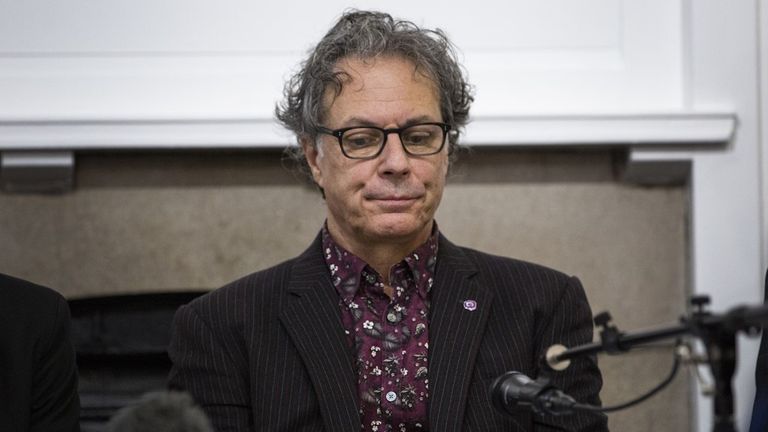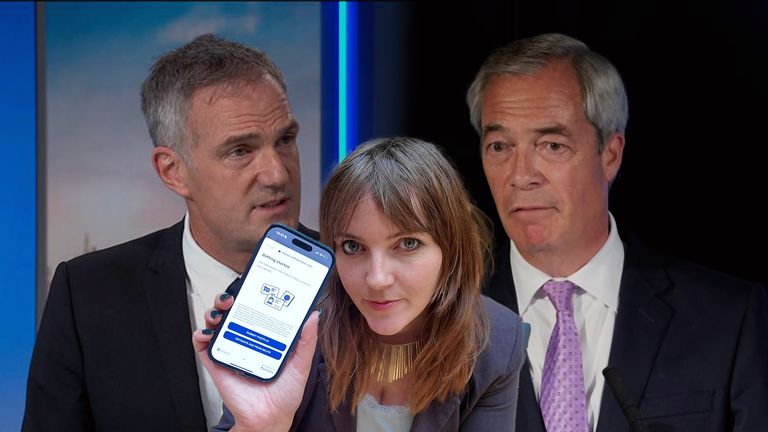TikTok and Instagram accused of targeting teens with suicide and self-harm content


TikTok and Instagram have been accused of targeting teenagers with suicide and self-harm content – at a higher rate than two years ago.
The Molly Rose Foundation – set up by Ian Russell after his 14-year-old daughter took her own life after viewing harmful content on social media – commissioned analysis of hundreds of posts on the platforms, using accounts of a 15-year-old girl based in the UK.
Politics Hub: Follow latest updates
The charity claimed videos recommended by algorithms on the For You pages continued to feature a “tsunami” of clips containing “suicide, self-harm and intense depression” to under-16s who have previously engaged with similar material.
One in 10 of the harmful posts had been liked at least a million times. The average number of likes was 226,000, the researchers said.
Mr Russell told Sky News the results were “horrifying” and showed online safety laws are not fit for purpose.
‘This is happening on PM’s watch’
He said: “It is staggering that eight years after Molly’s death, incredibly harmful suicide, self-harm, and depression content like she saw is still pervasive across social media.
“Ofcom’s recent child safety codes do not match the sheer scale of harm being suggested to vulnerable users and ultimately do little to prevent more deaths like Molly’s.
“The situation has got worse rather than better, despite the actions of governments and regulators and people like me. The report shows that if you strayed into the rabbit hole of harmful suicide self-injury content, it’s almost inescapable.
“For over a year, this entirely preventable harm has been happening on the prime minister’s watch and where Ofcom have been timid it is time for him to be strong and bring forward strengthened, life-saving legislation without delay.”

After Molly’s death in 2017, a coroner ruled she had been suffering from depression, and the material she had viewed online contributed to her death “in a more than minimal way”.
Researchers at Bright Data looked at 300 Instagram Reels and 242 TikToks to determine if they “promoted and glorified suicide and self-harm”, referenced ideation or methods, or “themes of intense hopelessness, misery, and despair”.
They were gathered between November 2024 and March 2025, before new children’s codes for tech companies under the Online Safety Act came into force in July.
Please use Chrome browser for a more accessible video player

3:53
What are the new online rules?
The Molly Rose Foundation claimed Instagram “continues to algorithmically recommend appallingly high volumes of harmful material”.
The researchers said 97% of the videos recommended on Instagram Reels for the account of a teenage girl, who had previously looked at this content, were judged to be harmful.
Some 44% actively referenced suicide and self-harm, they said. They also claimed harmful content was sent in emails containing recommended content for users.
A spokesperson for Meta, which owns Instagram, said: “We disagree with the assertions of this report and the limited methodology behind it.
“Tens of millions of teens are now in Instagram Teen Accounts, which offer built-in protections that limit who can contact them, the content they see, and the time they spend on Instagram.
“We continue to use automated technology to remove content encouraging suicide and self-injury, with 99% proactively actioned before being reported to us. We developed Teen Accounts to help protect teens online and continue to work tirelessly to do just that.”
TikTok
TikTok was accused of recommending “an almost uninterrupted supply of harmful material”, with 96% of the videos judged to be harmful, the report said.
Over half (55%) of the For You posts were found to be suicide and self-harm related; a single search yielding posts promoting suicide behaviours, dangerous stunts and challenges, it was claimed.
The number of problematic hashtags had increased since 2023; with many shared on highly-followed accounts which compiled ‘playlists’ of harmful content, the report alleged.
A TikTok spokesperson said: “Teen accounts on TikTok have 50+ features and settings designed to help them safely express themselves, discover and learn, and parents can further customise 20+ content and privacy settings through Family Pairing.
“With over 99% of violative content proactively removed by TikTok, the findings don’t reflect the real experience of people on our platform which the report admits.”
According to TikTok, they not do not allow content showing or promoting suicide and self-harm, and say that banned hashtags lead users to support helplines.
Read more:
Backlash against new online safety rules
Musk’s X wants ‘significant’ changes to OSA
Please use Chrome browser for a more accessible video player

5:23
Why do people want to repeal the Online Safety Act?
‘A brutal reality’
Both platforms allow young users to provide negative feedback on harmful content recommended to them. But the researchers found they can also provide positive feedback on this content and be sent it for the next 30 days.
Technology Secretary Peter Kyle said: “These figures show a brutal reality – for far too long, tech companies have stood by as the internet fed vile content to children, devastating young lives and even tearing some families to pieces.
“But companies can no longer pretend not to see. The Online Safety Act, which came into effect earlier this year, requires platforms to protect all users from illegal content and children from the most harmful content, like promoting or encouraging suicide and self-harm. 45 sites are already under investigation.”
An Ofcom spokesperson said: “Since this research was carried out, our new measures to protect children online have come into force.
“These will make a meaningful difference to children – helping to prevent exposure to the most harmful content, including suicide and self-harm material. And for the first time, services will be required by law to tame toxic algorithms.
“Tech firms that don’t comply with the protection measures set out in our codes can expect enforcement action.”

‘A snapshot of rock bottom’
A separate report out today from the Children’s Commissioner found the proportion of children who have seen pornography online has risen in the past two years – also driven by algorithms.
Rachel de Souza described the content young people are seeing as “violent, extreme and degrading”, and often illegal, and said her office’s findings must be seen as a “snapshot of what rock bottom looks like”.
More than half (58%) of respondents to the survey said that, as children, they had seen pornography involving strangulation, while 44% reported seeing a depiction of rape – specifically someone who was asleep.
The survey of 1,020 people aged between 16 and 21 found that they were on average aged 13 when they first saw pornography. More than a quarter (27%) said they were 11, and some reported being six or younger.
Anyone feeling emotionally distressed or suicidal can call Samaritans for help on 116 123 or email jo@samaritans.org in the UK. In the US, call the Samaritans branch in your area or 1 (800) 273-TALK.